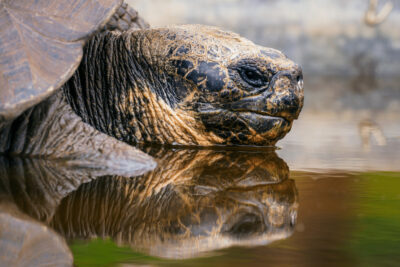Curiosity about the natural habitats and behaviors of animals often leads us to question their adaptability to different environments. One such intriguing inquiry revolves around the tortoise, a creature known for its slow and steady movements on land. While we commonly associate tortoises with terrestrial life, the question arises: Can tortoises live in water?
In this article, we delve into the fascinating world of tortoises to uncover the extent of their aquatic abilities and understand how these resilient reptiles navigate the realms beyond solid ground. Join us on a journey to discover the surprising facets of a tortoise’s life and whether the aquatic domain is a place they can truly call home.
Can tortoise live in water?

Tortoises are generally terrestrial reptiles and are not adapted to live in water like turtles. While some species of turtles spend a significant amount of time in water, tortoises are better suited for a land-based habitat.
Also, tortoises have sturdy, elephant-like legs with columnar feet designed for walking on land, and their shells are usually higher and more dome-shaped compared to the flatter, streamlined shells of aquatic turtles.
While tortoises can swim, they are not as well adapted to aquatic life as turtles. Swimming for a tortoise is usually a survival skill rather than a preferred activity. In general, it’s important to provide a suitable habitat for the specific needs of the tortoise species you are caring for, with access to a water source for drinking and occasional soaking, but not necessarily for constant swimming.
If you have a pet tortoise, it’s crucial to research and understand the specific requirements of its species to ensure you are providing the appropriate environment, diet, and care. Always consult with a veterinarian or a reptile expert for guidance on the proper care of your specific tortoise species.
Tortoises are not adapted for efficient swimming like aquatic turtles, but they can move through water if necessary. Their anatomy and behavior have certain features that enable them to navigate in water to some extent:
- Buoyancy: Tortoises have a relatively flat and broad shell, which helps them stay afloat in water. The shell is not as streamlined as that of aquatic turtles, but it provides some buoyancy.
- Limb Movement: While tortoises are not built for efficient swimming, they can move their legs in a paddling motion, allowing them to propel themselves through water to some extent. This movement is not as effective as that of aquatic turtles, but it helps them navigate short distances.
- Nose and Mouth Placement: The positioning of the nose and mouth on the top of the head allows a tortoise to breathe while keeping most of its body submerged. This adaptation allows them to remain in the water for a while without having to come up for air frequently.
- Traversing Shallow Water: Some species of tortoises are adapted to crossing shallow bodies of water during migrations or movements. They can use their limbs to walk along the bottom, and their buoyant shell helps them stay partially submerged.
- Hibernation in Water: Some tortoise species, such as the European pond turtle (Emys orbicularis), are known to hibernate in bodies of water. During hibernation, they can slow down their metabolic processes and endure colder temperatures.
It’s important to note that while tortoises can navigate in water, they are not true aquatic animals, and their adaptations for water movement are limited compared to species specifically evolved for an aquatic lifestyle.
How do tortoises interact with aquatic ecosystems?
Tortoises interact with aquatic ecosystems in various ways, depending on the species and their habitat. While they are primarily terrestrial animals, some tortoises may venture into aquatic environments for specific reasons.
Here are some ways in which tortoises interact with aquatic ecosystems:
- Drinking and Bathing: Tortoises need water for drinking and bathing. In the wild, they may visit water sources such as ponds, streams, or puddles to drink and soak. This behavior is crucial for maintaining hydration and cleaning their shells.
- Foraging: Some tortoise species may forage for aquatic vegetation, including water plants and algae, at the water’s edge. This behavior is more common in species that inhabit areas with both terrestrial and aquatic vegetation.
- Migration: Certain tortoise species, like the European pond turtle (Emys orbicularis), are semi-aquatic and may migrate between terrestrial and aquatic habitats. They might move to bodies of water for breeding, foraging, or hibernation.
- Hibernation: Some tortoises, especially those in temperate climates, hibernate in aquatic environments. They may bury themselves in the mud at the bottom of ponds or shallow water bodies during the colder months, slowing down their metabolism until the weather becomes more favorable.
- Egg-Laying: Female tortoises may choose nesting sites near water sources to lay their eggs. This proximity ensures that the eggs receive adequate moisture during the incubation period, promoting successful hatching.
- Basking: Tortoises, including aquatic or semi-aquatic species, often bask in the sun. They may emerge from the water and climb onto rocks or logs to absorb heat, which helps regulate their body temperature and aids in digestion.
- Interactions with Other Species: Tortoises may share their aquatic habitats with other wildlife, such as fish, amphibians, and invertebrates. These interactions can have ecological implications, as tortoises contribute to nutrient cycling and may serve as a part of the food web.
So, while tortoises interact with aquatic ecosystems, their primary adaptations are for a terrestrial lifestyle. Their interactions with aquatic environments are often influenced by factors such as climate, habitat availability, and species-specific behaviors.
Types of water environments where tortoises thrive
While most tortoise species are primarily terrestrial, some are adapted to or have a preference for semi-aquatic or aquatic environments. These environments vary, but they generally include areas with accessible water sources.
Here are some types of water environments where certain tortoise species thrive:
- Ponds and Lakes:
- Some species, such as the European pond turtle (Emys orbicularis), are well adapted to living in and around ponds and lakes. They may spend a significant amount of time in the water, foraging for aquatic vegetation and hunting for small aquatic animals.
- Streams and Rivers:
- Tortoises like the North American river cooter (Pseudemys concinna) are often found in and around streams and rivers. They can move easily through shallow water and bask on rocks or logs along the water’s edge.
- Marshes and Wetlands:
- Certain tortoise species inhabit marshes and wetlands, where they can find a mix of terrestrial and aquatic vegetation. The Aldabra giant tortoise (Aldabrachelys gigantea) is known to inhabit coastal areas and may access brackish or saltwater marshes.
- Seasonal Pools:
- Some tortoises, like the desert tortoise (Gopherus agassizii), may inhabit areas with seasonal pools of water. These pools provide a water source during certain times of the year and are essential for drinking and maintaining hydration.
- Riparian Zones:
- Tortoises may be found in riparian zones, which are areas along the banks of rivers and streams. These zones often provide a mix of terrestrial and aquatic vegetation, creating a suitable habitat for tortoises that can move between land and water.
- Coastal Environments:
- Certain tortoise species, such as the Aldabra giant tortoise, inhabit coastal regions and may have access to both freshwater and saltwater sources. These tortoises can be found on islands and coastal areas where they can interact with marine and terrestrial ecosystems.
- Farm Ponds and Reservoirs:
- In some regions, tortoises may thrive in man-made water bodies such as farm ponds and reservoirs. The availability of water and surrounding vegetation can create suitable conditions for these animals.
In addition, the specific water requirements and adaptations vary among tortoise species, and their distribution is influenced by factors such as climate, vegetation, and geographic location.
Risks associated with prolonged exposure to aquatic habitats

Prolonged exposure to aquatic habitats can pose various risks to individuals, depending on the specific conditions of the environment.
Here are some potential risks associated with spending extended periods in aquatic habitats:
- Waterborne Diseases:
-
- Stagnant or contaminated water can harbor bacteria, viruses, and parasites that may cause waterborne diseases such as diarrhea, gastroenteritis, and skin infections.
- Vector-Borne Diseases:
-
- Aquatic environments may be breeding grounds for disease-carrying vectors such as mosquitoes. Exposure to these vectors can increase the risk of diseases like malaria, dengue fever, and Zika virus.
- Chemical Exposure:
-
- Aquatic habitats can contain pollutants, chemicals, and toxins from industrial discharges, agricultural runoff, or natural sources. Prolonged exposure to these substances may lead to adverse health effects, including skin irritation, respiratory problems, or long-term health issues.
- Aquatic Life Hazards:
-
- Some aquatic environments may be home to hazardous aquatic life, such as venomous or aggressive species. Contact with certain aquatic organisms can result in bites, stings, or allergic reactions.
- Hypothermia or Hyperthermia:
-
- Prolonged exposure to cold water can lead to hypothermia, while exposure to excessively warm water can cause hyperthermia. Both conditions can have serious health consequences.
- Physical Hazards:
-
- Underwater obstacles, strong currents, and rough water conditions can pose physical hazards, increasing the risk of injuries such as cuts, bruises, or fractures.
- Sun Exposure:
-
- Spending extended periods in aquatic environments, especially in sunny conditions, can increase the risk of sunburn and long-term skin damage due to prolonged exposure to ultraviolet (UV) radiation.
- Dehydration:
-
- While surrounded by water, individuals in aquatic habitats may not have access to safe drinking water. Dehydration can occur, particularly in situations where fresh water is not readily available.
- Injuries and Accidents:
-
- Activities such as swimming, diving, or boating come with inherent risks. Accidents such as drowning, collisions, or falls can occur, especially in environments with unpredictable conditions.
- Water Quality Issues:
-
- Poor water quality, including low oxygen levels, can lead to respiratory distress and other health problems. Harmful algal blooms, for example, can release toxins that can be harmful to both humans and aquatic life.
To mitigate these risks, individuals should be aware of their surroundings, take necessary precautions, and follow safety guidelines when spending extended periods in aquatic habitats. These may include using appropriate protective gear, avoiding known polluted areas, and being mindful of local wildlife and environmental conditions.
Challenges tortoises face in aquatic environments
Tortoises are primarily terrestrial reptiles and are not adapted for life in aquatic environments. While some turtle species are adapted for aquatic life, tortoises are not equipped for prolonged exposure to water.
If a tortoise finds itself in an aquatic environment, it may face several challenges:
- Buoyancy and Drowning Risk:
-
- Tortoises have a heavy shell that makes them poorly buoyant. If they accidentally fall into deep water, they may struggle to stay afloat and may be at risk of drowning.
- Limited Swimming Ability:
-
- Unlike aquatic turtles, tortoises are not built for efficient swimming. Their limbs are adapted for walking on land, not for propelling themselves through water. This makes it difficult for them to navigate and swim effectively.
- Waterlogged Shell:
-
- Tortoise shells are not designed to withstand prolonged exposure to water. Absorption of water can make the shell soft and more susceptible to fungal infections and diseases.
- Inability to Regulate Body Temperature:
-
- Tortoises are ectothermic, meaning they rely on external sources to regulate their body temperature. Immersion in water can disrupt their ability to control body temperature, potentially leading to health issues.
- Limited Foraging Opportunities:
-
- Tortoises are herbivores adapted to terrestrial vegetation. Aquatic environments may lack suitable food sources for tortoises, leading to malnutrition if they are unable to find appropriate nourishment.
- Predator Exposure:
-
- Tortoises in aquatic environments may face increased exposure to aquatic predators that they are not adapted to evade or defend against. This can include fish, amphibians, or other aquatic predators.
- Loss of Territorial and Habitat Familiarity:
-
- Tortoises are territorial animals and often have specific home ranges and habitats. Being in an unfamiliar aquatic environment can lead to stress and disorientation.
- Difficulty in Breathing:
-
- Tortoises are adapted for breathing air, and prolonged submersion can make it challenging for them to access air. This can lead to respiratory distress and other health issues.
- Altered Digestive Function:
-
- The digestive systems of tortoises are not adapted to process food in a waterlogged environment. Submersion can lead to digestive problems and impact their ability to obtain necessary nutrients.
- Lack of Shelter and Basking Sites:
-
- Tortoises require access to basking sites to regulate their body temperature. Aquatic environments may lack suitable places for basking and shelter, further impacting their overall well-being.
If a tortoise is found in an aquatic environment, it’s important to assist it in returning to a suitable terrestrial habitat. Tortoises are not equipped to thrive in water, and prolonged exposure can have detrimental effects on their health and survival.

Risks associated with tortoise exposure to aquatic habitats
Exposing a tortoise to aquatic habitats can pose several risks to their health and well-being:
- Drowning: Tortoises are not natural swimmers and can easily drown if they fall into deep water or are unable to get out of a pond or pool. Their anatomy is not adapted for swimming, and they can tire quickly in water.
- Respiratory Infections: Prolonged exposure to damp or wet conditions can lead to respiratory infections in tortoises. This can occur if they are unable to properly dry off or if they’re constantly in moist environments.
- Shell Rot: Extended periods in damp conditions can cause the tortoise’s shell to soften, leading to shell rot—a fungal or bacterial infection that affects the shell. This condition can be painful and detrimental to their health.
- Temperature Regulation: Aquatic environments might not provide the necessary warmth for a tortoise. If the water is too cold, it can lead to health issues related to temperature regulation.
- Stress and Behavioral Changes: Tortoises are terrestrial creatures and are generally not equipped to handle aquatic environments. Being placed in water can cause stress and behavioral changes, affecting their overall well-being.
- Predation: In natural aquatic environments, tortoises can be vulnerable to predators they wouldn’t typically encounter on land, increasing their risk of injury or death.
- Chemical Exposure: Water in man-made ponds or aquatic habitats may contain chemicals like chlorine or other contaminants, which can harm the tortoise if ingested or absorbed through their skin.
It’s crucial to provide an appropriate environment for tortoises, with dry, warm, and spacious habitats that allow them to exhibit their natural behaviors.
If a tortoise needs to be cleaned or soaked for health reasons, it should be done under supervision and in shallow water for short periods, followed by thorough drying to prevent any potential issues.
Conclusion
This page answers the question on can tortoise live in water. Tortoises are not adapted for aquatic living, and prolonged exposure to water poses significant risks to their health.
Issues such as drowning, respiratory infections, shell rot, temperature regulation challenges, stress, and potential chemical exposure make aquatic habitats unsuitable for tortoises. It is essential to provide them with dry, warm environments that mimic their natural habitat for optimal well-being.

